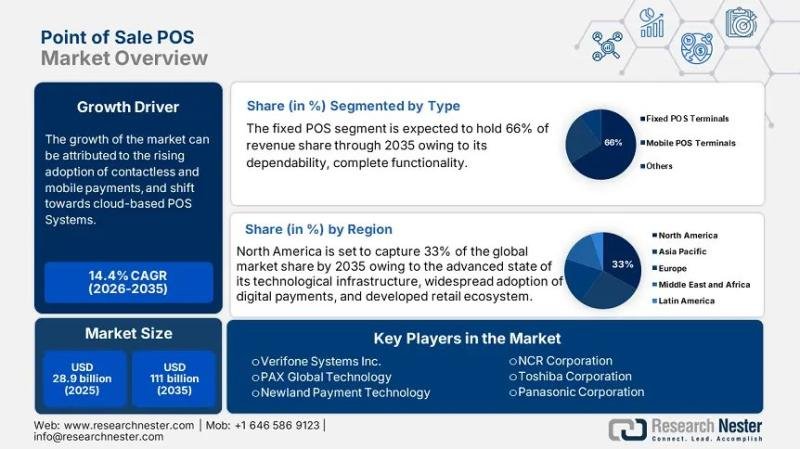Market Outlook and Forecast
The Point of Sale (POS) market is experiencing an accelerated phase of transformation, driven by the digitalization of commerce, omnichannel retail expansion, and the integration of AI-powered analytics. From traditional cash registers to cloud-based payment ecosystems, the POS industry is redefining how transactions, customer engagement, and business operations converge in real time.
According to recent market research, the global POS market is estimated at USD 28.9 billion in 2025 and is projected to reach USD 111 billion by 2035, reflecting a CAGR of 14.4% from 2026 to 2035. This growth trajectory underscores a structural shift toward mobility, cloud adoption, and software-driven ecosystems that enable retailers and service providers to enhance speed, security, and personalization in customer experiences.
The POS market’s evolution extends beyond mere payment acceptance-it has become a central nervous system for businesses, integrating sales, inventory, analytics, and loyalty management into unified platforms that empower data-driven decision-making.
Discover how the Point of Sale Market is evolving globally – access your free sample report → https://www.researchnester.com/sample-request-264
Regional Performance Highlights
North America is anticipated to maintain leadership, accounting for 33% of the global POS market by 2035. The region’s growth is supported by robust digital payment infrastructure, widespread adoption of contactless payment technologies, and strong presence of key players such as NCR, Oracle, and Square. Additionally, the ongoing replacement of legacy systems with cloud-native and mobile POS solutions continues to fuel the North American market.
Europe demonstrates steady expansion, supported by the European Union’s push toward cashless economies, strict compliance standards, and digital transformation in the hospitality and retail sectors. Increasing adoption of EMV-enabled devices and advanced data encryption solutions has also strengthened the region’s position in secure transaction systems.
Asia Pacific is expected to emerge as the fastest-growing region, driven by rapid digital payment penetration in countries like China, India, and Japan. Government initiatives promoting financial inclusion, smartphone proliferation, and the rise of small and medium enterprises (SMEs) adopting cost-effective mobile POS terminals are key enablers of growth. Asia Pacific’s e-commerce surge and preference for QR-based and tap-to-pay transactions have further established it as a dynamic hub for POS innovation.
Together, these regions illustrate how the global POS landscape is balancing mature adoption in developed economies with rapid technological leapfrogging across emerging markets, setting the stage for a fully connected, intelligent commerce ecosystem.
Gain access to expanded insights on competitive strategies, market size, and regional analysis. View our Point of Sale Market Report Overview here: https://www.researchnester.com/reports/point-of-sale-pos-market/264
Segment Demand and Use Cases
From a segmentation standpoint, the POS market is evolving toward flexibility, integration, and mobility-driven by shifting customer expectations and retail modernization:
• Fixed POS Terminals continue to dominate with an estimated 66% share by 2035. Their enduring relevance in high-volume retail, hospitality, and quick-service restaurants is linked to robust processing capabilities, multiple hardware integrations, and support for omnichannel transactions.
• Retail Segment is projected to account for 46% of total market share by 2035, reflecting the sector’s central role in adopting next-generation POS systems to streamline checkout experiences, integrate online and offline channels, and capture real-time consumer insights.
Beyond retail, POS adoption is expanding rapidly in hospitality, healthcare, transportation, and entertainment. Restaurants are leveraging POS for inventory synchronization and online ordering, while hospitals and clinics deploy it for billing automation and patient management. In emerging economies, small merchants are increasingly turning to mobile POS (mPOS) solutions, driven by affordability, portability, and digital-wallet integrations.
In essence, the POS market’s segmentation highlights how hardware reliability, cloud connectivity, and industry-specific customization are shaping adoption patterns across the global business ecosystem.
Explore the complete Point of Sale Market forecast and regional insights in our detailed report. Download our sample report here → https://www.researchnester.com/sample-request-264
Top Market Trends
The global POS market is undergoing fundamental change as digital transformation accelerates across industries. Below are four key trends reshaping this dynamic space.
1. Rise of Cloud-Based and Mobile POS Platforms
The transition from on-premises POS systems to cloud-based architectures represents one of the most significant paradigm shifts in the industry. Businesses are embracing cloud POS solutions for scalability, remote accessibility, and real-time synchronization across multiple locations.
Cloud-native platforms like Square, Toast, and Lightspeed have become synonymous with agility and innovation, empowering SMEs to manage transactions, analytics, and customer data from anywhere. The surge in mobile POS (mPOS) adoption further complements this trend, enabling seamless in-store mobility, pop-up retail operations, and contactless payments.
For instance, Block, Inc. (Square) expanded its cloud capabilities in 2025 by integrating AI-driven inventory tracking and subscription-based analytics modules, emphasizing software as a service (SaaS) over hardware reliance.
2. Integration of AI, Analytics, and Customer Intelligence
Artificial intelligence and predictive analytics are now integral to POS systems, transforming raw transaction data into actionable insights. Retailers use AI-enhanced POS software to forecast demand, personalize offers, and optimize staffing based on real-time foot traffic patterns.
AI-enabled POS platforms like Shopify POS Pro and Oracle MICROS Simphony leverage data analytics to improve customer retention through loyalty programs and omnichannel marketing. By embedding machine learning into daily operations, businesses can reduce manual errors, improve operational efficiency, and elevate consumer engagement.
This shift positions POS systems not only as transaction tools but also as intelligence hubs that drive business strategy, aligning with the broader trend of data-centric commerce.
3. Contactless, QR, and Biometric Payment Expansion
Driven by pandemic-era shifts and evolving consumer expectations, contactless payments have become the new standard. The integration of NFC, QR, and biometric authentication within POS systems has accelerated across all major economies.
In 2025, Apple Pay, Google Pay, and regional wallets like Paytm and Alipay expanded their partnerships with POS manufacturers to enable secure, frictionless payments at both large retailers and micro-businesses.
Emerging biometric technologies, including fingerprint and facial recognition POS, are further redefining transaction security. These innovations not only enhance speed but also improve compliance with evolving Know Your Customer (KYC) and anti-fraud regulations.
The growing interoperability between POS systems and digital wallets is enabling a truly cashless, seamless payment environment, laying the foundation for the next era of retail convenience.
4. Sustainability and ESG Alignment in POS Hardware
As sustainability becomes a defining business priority, the POS ecosystem is aligning with environmental, social, and governance (ESG) goals. Manufacturers are shifting toward energy-efficient terminals, recyclable materials, and cloud-based systems that reduce paper waste and hardware obsolescence.
Companies such as Verifone and Ingenico have introduced low-power terminals and e-receipt systems to minimize environmental impact. Similarly, software providers are promoting paperless transactions, integrating eco-friendly features that resonate with conscious consumers and green retailers alike.
This growing sustainability focus underscores a deeper transformation: the POS industry is moving beyond efficiency to embrace responsible innovation, reflecting global shifts toward ethical commerce.
Unlock detailed analysis of key market trends transforming hybrid mobility. Get your sample report → https://www.researchnester.com/sample-request-264
Recent Company Developments
The POS market remains vibrant and highly competitive, characterized by consolidation, product innovation, and strategic alliances. Below are recent developments from leading and emerging players shaping the industry landscape.
1. NCR Corporation – In early 2025, NCR advanced its self-service portfolio with AI-enabled checkout and real-time analytics integration for omnichannel retail operations. The company also expanded its cloud-hosted NCR Commerce Platform for SMBs.
2. Oracle Corporation – Through its MICROS Simphony platform, Oracle introduced AI-enhanced customer experience modules and integrations with delivery aggregators, strengthening its foothold in hospitality POS.
3. Block, Inc. (Square) – Expanded into enterprise retail solutions with enhanced mobile POS hardware and subscription-based analytics tools. The company continues to pioneer software-driven ecosystems for small businesses.
4. Toast, Inc. – Introduced Toast Tableside in mid-2025, featuring portable devices that enable pay-at-table convenience and real-time order tracking for restaurants. The company also launched an ESG-focused sustainability dashboard for hospitality clients.
5. Lightspeed Commerce Inc. – Acquired a European retail software startup to deepen its omnichannel integration capabilities and bolster AI-driven analytics. Its Lightspeed Retail X platform is gaining strong traction among SMEs.
See which companies and policy changes are reshaping the market. Download a complimentary Point of Sale Market sample report → https://www.researchnester.com/sample-request-264
These company developments highlight the strategic convergence of hardware innovation, cloud intelligence, and fintech integration. As POS technology continues to merge with digital ecosystems, the industry is moving toward unified commerce platforms that empower retailers, streamline payments, and enable adaptive business intelligence.
Related News –
https://www.linkedin.com/pulse/can-mobile-wireless-backhaul-unlock-next-era-network-usv1f
https://www.linkedin.com/pulse/why-businesses-investing-heavily-building-automation-azuof
Contact Data
AJ Daniel
Corporate Sales, USA
Research Nester
77 Water Street 8th Floor, New York, 10005
Email: info@researchnester.com
USA Phone: +1 646 586 9123
Europe Phone: +44 203 608 5919
About Research Nester
Research Nester is a one-stop service provider with a client base in more than 50 countries, leading in strategic market research and consulting with an unbiased and unparalleled approach towards helping global industrial players, conglomerates and executives for their future investment while avoiding forthcoming uncertainties. With an out-of-the-box mindset to produce statistical and analytical market research reports, we provide strategic consulting so that our clients can make wise business decisions with clarity while strategizing and planning for their forthcoming needs and succeed in achieving their future endeavors. We believe every business can expand to its new horizon, provided a right guidance at a right time is available through strategic minds.
This release was published on openPR.















